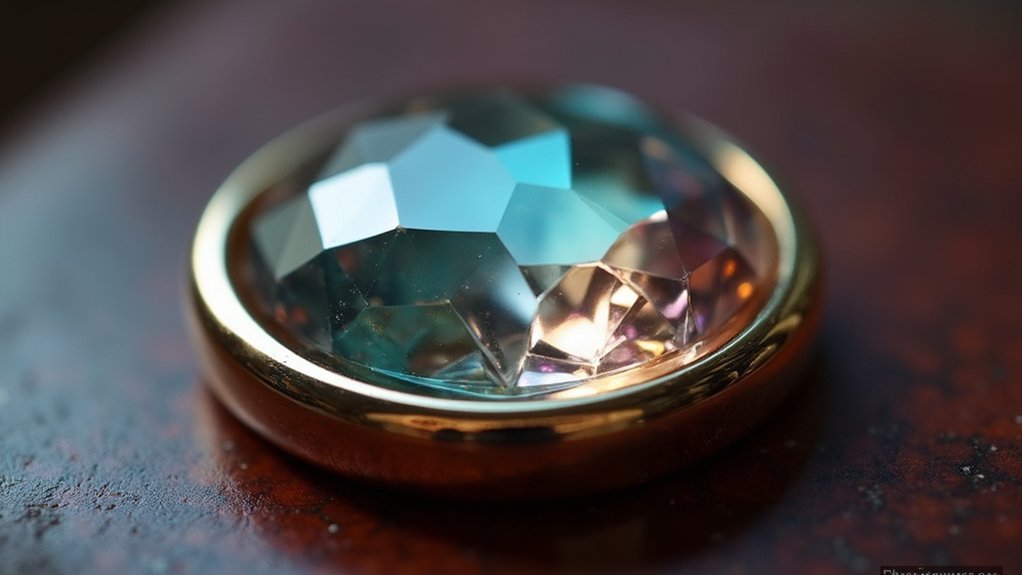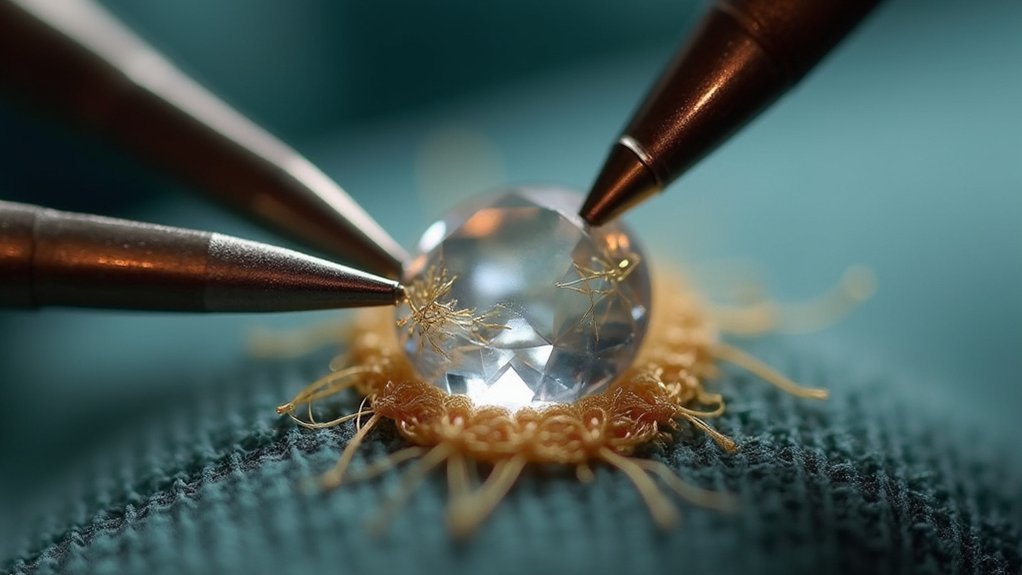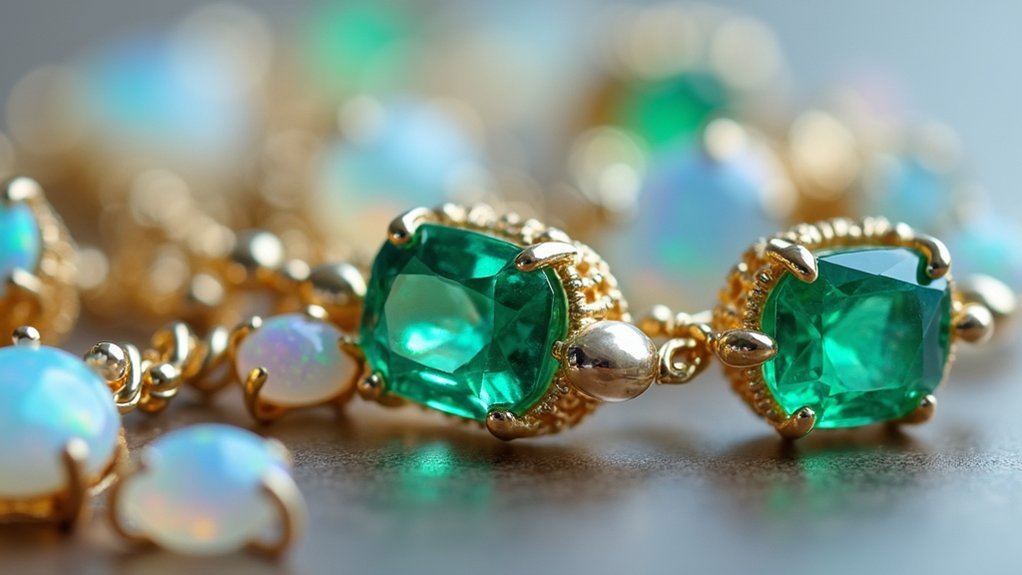You’ll protect delicate gemstones effectively using these five proven techniques: bezel settings that completely encircle stones with metal bands for maximum impact protection, cushioning materials like silicone or soft fabrics that absorb shock and prevent scratches, proper pressure application with gradual securing methods using tools at 45° angles, channel settings that position small gems flush between metal strips, and tension-style mountings that create floating appearances while maintaining security. Master these approaches to discover professional-level stone protection secrets.
Bezel Setting: The Ultimate Protection for Fragile Stones

When you’re working with fragile gemstones like opals, amber, or pearls, a bezel setting offers unmatched protection that other mounting styles simply can’t provide. This technique completely encircles your delicate stones with a thin metal band, creating robust defense against chipping and impacts.
You’ll appreciate the enhanced wearability since the setting minimizes snagging risks on clothing or objects. Cleaning becomes effortless with fewer dirt-accumulating areas compared to prong settings.
Bezel settings eliminate snagging hazards and reduce maintenance with their smooth, streamlined design that repels dirt accumulation.
The versatility of bezel settings accommodates various cuts and unique shapes, ensuring even unusually formed stones mount securely. When you choose solid backings, you’ll boost your gemstone’s overall durability while maintaining ideal light passage for preserved brilliance.
This mounting method perfectly balances protection with aesthetic appeal for your most vulnerable stones.
Cushioning Materials and Soft Mounting Techniques
Beyond rigid metal settings, you’ll find that cushioning materials offer an additional layer of protection that can make the difference between a damaged stone and a preserved treasure.
Silicone, rubber, and soft fabric create protective layers that absorb shock during mounting. Soft mounting techniques utilize flexible settings like bezels and padded mounts that provide a snug fit, reducing movement and potential damage to delicate gemstones.
You can incorporate soft backing within settings to prevent direct metal contact, avoiding scratches and chips.
Materials with lower hardness than your gemstone, such as felt or foam, prevent abrasions while offering gentle support.
Tension settings with soft, rounded edges enhance security while allowing maximum exposure and brilliance without compromising your stone’s integrity.
Proper Pressure Application and Gradual Securing Methods

Although cushioning materials provide essential protection, applying the right amount of pressure during the actual setting process determines whether your gemstone survives the mounting intact. Proper pressure application prevents excessive force that can chip delicate gemstones like opals and amber.
Gradual securing methods guarantee longevity through controlled techniques. Use a burnisher at a 45° angle to gradually lock stones without overwhelming pressure. A pusher tool distributes force evenly around the gemstone’s perimeter for precise adjustments.
| Tool | Angle | Pressure Level |
|---|---|---|
| Burnisher | 45° | Light-Medium |
| Pusher Tool | Variable | Even Distribution |
| Setting Bur | Perpendicular | Gradual Increase |
| Bezel Roller | 30-45° | Progressive |
| Stone Setter | Direct | Controlled |
For flush settings, start with smaller burs and gradually increase size to prevent skittering. Regularly check stability and adjust seating depth throughout the process to maintain secure positioning.
Channel Setting for Small Delicate Gemstones
Channel setting transforms small delicate gemstones into secure, low-profile arrangements that withstand daily wear better than most traditional mounting methods. This protective setting secures your gems flush between two horizontal metal strips, creating excellent protection against scratches and impacts.
You’ll appreciate how it minimizes snagging on clothing and surfaces during everyday activities.
While channel setting reduces brilliance compared to other protective settings since stones are partially covered, you’ll still enjoy sufficient visibility of your gems.
However, you’ll need dedicated maintenance as dirt accumulates in channels, making cleaning more challenging.
Remember that resizing becomes difficult and costly since bending channels loosens stones. You’ll want precise craftsmanship during initial mounting to guarantee your delicate gemstones remain secure long-term.
Tension-Style Settings for Enhanced Stone Safety

When you need maximum brilliance with superior protection, tension-style settings create a floating appearance that secures your gemstones between two precisely engineered metal bands. This innovative approach applies pressure on the stone while eliminating traditional prongs that might obstruct light entry, making it ideal for durable gemstones.
Consider these essential factors for enhanced stone safety:
- Strong Metal Selection – Use platinum or titanium for peak stone security
- Precise Engineering – Confirm exact measurements prevent resizing complications
- Regular Maintenance – Schedule inspections to monitor pressure mechanisms
- Proper Stone Selection – Choose durable gemstones that withstand sustained pressure
You’ll find tension settings showcase your gemstone’s brilliance while providing superior protection.
However, you must commit to consistent maintenance since the metal bands can wear down over time, potentially compromising your stone’s security.
Frequently Asked Questions
What Holds a Gemstone in Place?
You’ll find metal settings hold gemstones in place. Prong settings use metal claws gripping the stone’s top, bezel settings encircle stones completely, and channel settings secure gems between metal strips for protection.
What Is the Most Secure Gemstone Setting?
You’ll find the bezel setting offers the most security for your gemstones. It completely surrounds the stone with metal, protecting it from chips, scratches, and snags while providing maximum stability.
How Do You Protect Gemstones When Soldering?
You’ll protect gemstones when soldering by using wet tissue or sand shields, applying heat sinks like metal clamps, choosing low-temperature solder, and preheating the metal to prevent thermal shock.
How Do You Set Gems With No Metal Showing?
You’ll use invisible setting technique, placing square or rectangular stones side by side without visible metal. Cut gems precisely so they fit snugly together, creating seamless appearance while holding each other in place securely.
In Summary
You’ve learned the essential techniques for protecting delicate gemstones during mounting. By choosing bezel settings for fragile stones, using proper cushioning materials, applying gradual pressure, utilizing channel settings for small gems, and considering tension-style options, you’ll markedly reduce the risk of damage. Remember that patience and careful technique are your best tools when working with vulnerable stones. Practice these methods consistently, and you’ll master the art of safe gemstone mounting while preserving each stone’s natural beauty and integrity.





Leave a Reply